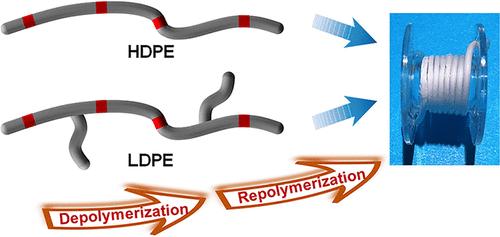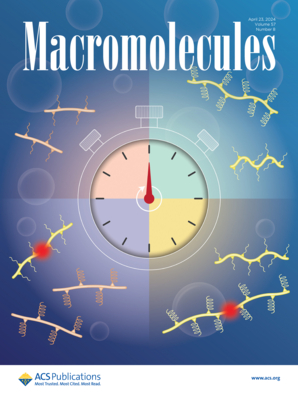Modulating Polyethylene Mimics with Degradability via Synthesis and Modeling
IF 5.1
1区 化学
Q1 POLYMER SCIENCE
引用次数: 0
Abstract
Polyethylene (PE) is one of the most important and widely used commodity polymers in the world. It is also among the vital and notoriously nondegradable plastics. Recent efforts are revisiting different approaches to create new generations of PE mimics. We report a model system to explore mimics of functionalized high-density polyethylene (HDPE) and low-density polyethylene (LDPE) via ring-opening metathesis polymerization (ROMP) and thiol–ene click chemistry. By combining experimental and computational studies, we demonstrated that the properties of PE mimics are highly tunable by changing the ester-to-methylene ratio (E:M), with low E:M (e.g., 1:413) functional polymers having characteristics similar to those of HDPE. Controlling the branch-to-methylene ratio (B:M) from 1:159 to 1:22 provided a handle for mimicking the transformation from HDPE to LDPE characteristics. The PE mimics exhibit competitive mechanical properties, melting temperature, and high molecular weight comparable to PE while being accessible via an efficient synthetic route. Notably, the PE mimics can be degraded into oligomers and then recycled, demonstrating the potential for circularity and sustainability. This study provides valuable insights into predicting the properties of aliphatic long-chain functional polymers to mimic PE.

聚乙烯(PE)是世界上最重要、应用最广泛的商品聚合物之一。它也是重要的、臭名昭著的不可降解塑料之一。最近,人们正在重新研究不同的方法,以创造新一代的聚乙烯模拟物。我们报告了一个模型系统,通过开环偏聚(ROMP)和巯基烯点击化学来探索功能化高密度聚乙烯(HDPE)和低密度聚乙烯(LDPE)的模拟物。通过实验和计算研究的结合,我们证明了通过改变酯与亚甲基的比率(E:M),聚乙烯模拟物的特性具有很高的可调性,低 E:M(如 1:413)功能聚合物具有与高密度聚乙烯相似的特性。将支链与亚甲基的比率(B:M)从 1:159 控制到 1:22,可以模拟从高密度聚乙烯到低密度聚乙烯特性的转变。聚乙烯模拟物具有与聚乙烯相当的机械性能、熔融温度和高分子量,同时可通过高效的合成路线获得。值得注意的是,聚乙烯模拟物可以降解成低聚物,然后进行回收利用,这证明了其循环性和可持续性的潜力。这项研究为预测脂肪族长链功能聚合物的特性以模拟聚乙烯提供了宝贵的见解。
本文章由计算机程序翻译,如有差异,请以英文原文为准。
求助全文
约1分钟内获得全文
求助全文
来源期刊

Macromolecules
工程技术-高分子科学
CiteScore
9.30
自引率
16.40%
发文量
942
审稿时长
2 months
期刊介绍:
Macromolecules publishes original, fundamental, and impactful research on all aspects of polymer science. Topics of interest include synthesis (e.g., controlled polymerizations, polymerization catalysis, post polymerization modification, new monomer structures and polymer architectures, and polymerization mechanisms/kinetics analysis); phase behavior, thermodynamics, dynamic, and ordering/disordering phenomena (e.g., self-assembly, gelation, crystallization, solution/melt/solid-state characteristics); structure and properties (e.g., mechanical and rheological properties, surface/interfacial characteristics, electronic and transport properties); new state of the art characterization (e.g., spectroscopy, scattering, microscopy, rheology), simulation (e.g., Monte Carlo, molecular dynamics, multi-scale/coarse-grained modeling), and theoretical methods. Renewable/sustainable polymers, polymer networks, responsive polymers, electro-, magneto- and opto-active macromolecules, inorganic polymers, charge-transporting polymers (ion-containing, semiconducting, and conducting), nanostructured polymers, and polymer composites are also of interest. Typical papers published in Macromolecules showcase important and innovative concepts, experimental methods/observations, and theoretical/computational approaches that demonstrate a fundamental advance in the understanding of polymers.
 求助内容:
求助内容: 应助结果提醒方式:
应助结果提醒方式:


